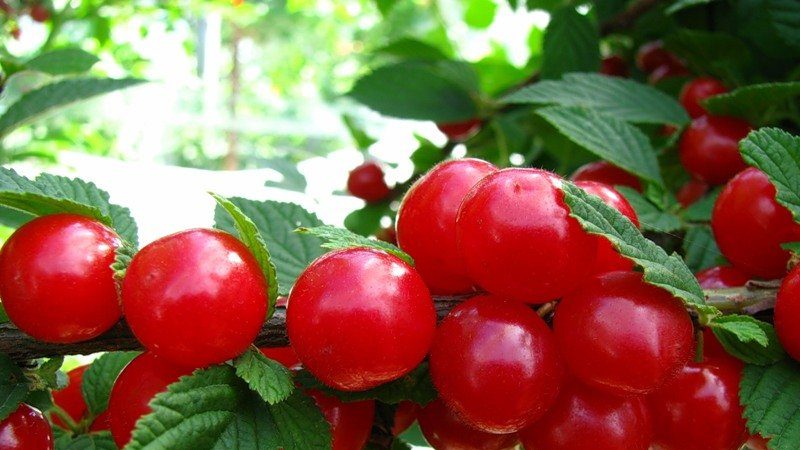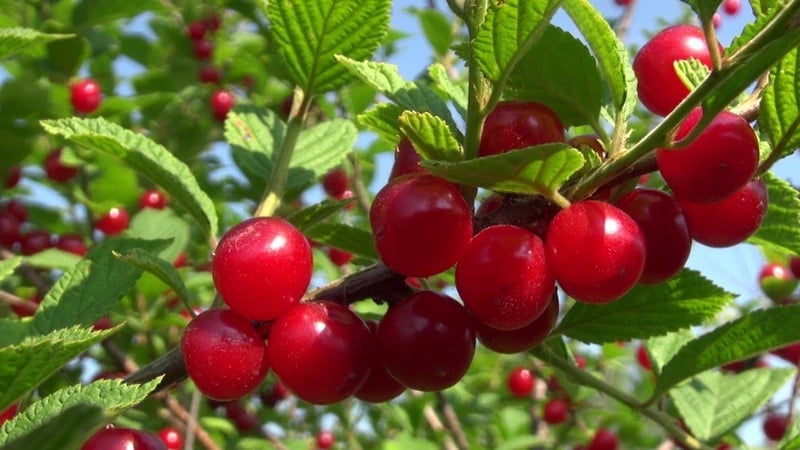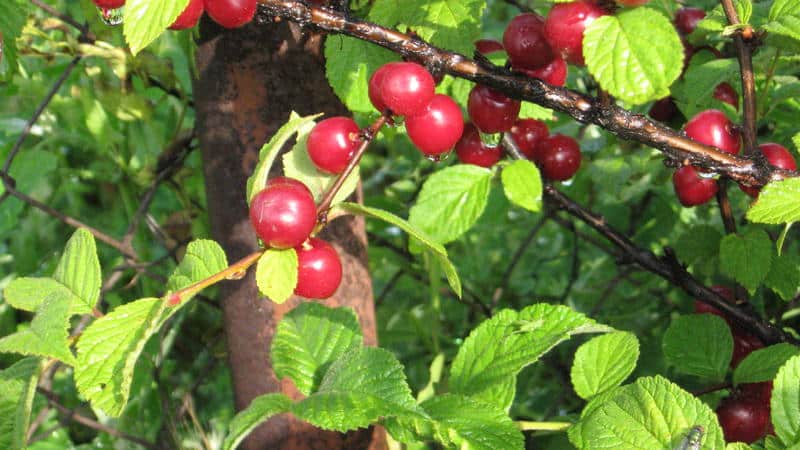Felt cherry - features and differences from ordinary
Felt cherry is a fruit and berry crop whose homeland is considered to be China. Now it is popular in Russia, Europe, Mongolia, and Asian countries. The plant is grown not only for its harvest. It is used in landscape design due to its abundant and beautiful flowering.
The fruits of the felt cherry are similar in taste and appearance to the berries of the common cherry, but they belong to a completely different genus - Plum. The plant can cross with peach, cherry plum, plum and apricot.
The article will tell you what the features of small cherries are, what else they are called and what methods of propagation exist.
General description of felt cherry

Felt cherry is a hardy and unpretentious plant. In its form it is more of a shrub than a tree. It is distinguished by unpretentiousness and endurance. It is actively grown as a cultivated plant and is often found in the wild.
It belongs to the Plum genus, but looks like a small cherry. It got its name because its leaves, young shoots and even fruits have light pubescence, reminiscent of felt.
Felt cherry is not the only name of the crop.
There are other names:
- felt;
- Far Eastern;
- bush;
- fluffy;
- Ando;
- tomentosis;
- Chinese cherry;
- Ussuri cherry (or plum).
Felt cherries are grown not only to produce a harvest of delicious sweet and sour berries. It is used in landscape design due to its decorative appearance during flowering and fruiting.The shrub tolerates pruning well and is used to create hedges and simply as a garden decoration.
note! In Asian countries, when people mention cherries, they usually mean the felt variety.
Main characteristics

Felt cherry, despite its name, has many differences from common cherry. A description of the main characteristics of the plant is presented in the list:
- Bush. The plant is a shrub, the height of which varies between 2-3 m. It is quite spreading, but with the help of shaping it can be given any shape. The branches are straight and directed upward. They are thin and not very durable. Young shoots are pubescent and green (sometimes with an anthocyanin tint) color. Old branches have dense bark of a gray-green hue.
- Leaves. Small, oval-shaped, with jagged edges. Light green in color with dense felt pubescence.
- Bloom. Abundant. Flowers of pink or white color densely cover the branches of the plant. The shrub begins to bloom in the second decade of May (earlier than ordinary cherry) and continues for more than 2 weeks. The plant is self-sterile; in order for fruit to set, it is necessary to plant several pollinators with which the crop is crossed.
- Fruit. Small, from 1.5 to 5 g. Usually red, but depending on the variety, their color varies from pink to almost black. Located on short petioles. The shoots of the plant are densely covered. The taste is sweet, with a slight sourness. The skin is thin, covered with slight pubescence. Ripening lasts about 10 days, after which the fruits do not fall off the bush for a long time. The rapid ripening of berries occurs 2 weeks earlier than in common cherries. The yield ranges from 7 to 20 kg of fruit per season.
- Frost resistance. High.Tolerates frosts down to 40°C in winter.
- Immunity. The culture is resistant to most cherry diseases.
The plant easily tolerates cold weather. Even during flowering, it is not afraid of frosts down to -3°C.
This is interesting! The berries of cherry bushes propagated vegetatively are larger than those obtained generatively.
Advantages and disadvantages over regular cherries

Chinese cherry has a number of advantages, which is why it is gaining increasing popularity among gardeners.
Main advantages:
- early fruiting (from the second half of June);
- uniform ripening of fruits and their ability to remain on the plant for a long time without falling off;
- attractive appearance during fruiting and flowering;
- resistance to drought and frost;
- high immunity to coccomycosis;
- ability to bear fruit already 2 years after planting;
- lack of root shoots;
- high yield.
Culture also has its disadvantages. These include:
- self-sterility;
- small fruit;
- low transportability of fruits;
- tendency of the bush to thicken;
- susceptibility to moniliosis;
- short lifespan of the plant (about 10 years).
With the help of rejuvenating pruning, the life of felt cherry is extended to 20 years.
This is interesting:
The best varieties of cherries for central Russia
Varieties and varieties of felt cherries
Even pitted Chinese cherry characterized by abundant flowering and fruiting. However, if the gardener’s task is to get a rich harvest of large and sweet fruits or a shrub with flowers and berries of an unusual color, then it is worth giving preference to varietal specimens.
There are a huge number of felt cherry varieties on the market.When choosing a suitable option, you should take into account the timing of ripening and flowering, taste, color and size of the fruit, immunity, as well as resistance to frost and other negative environmental factors.
It is equally important to pay attention to whether the variety you like is suitable for the climatic conditions of the region in which it will grow. Thus, Far Eastern varieties do not take root well in the Leningrad region and Moscow region, as they die from the root collar becoming warm. For Siberia, varieties with increased frost resistance are chosen.
Note! Self-fertile varieties include Belaya, Tsarevna, Vostorg, Ogonyok and Leto.
Early

Early varieties allow you to harvest as early as mid-July. These include:
- Natalie. Vigorous spreading bush. The flowers are pink. Dark red berries have a sweet and sour taste. The average yield is 9 kg per season.
- Amurskaya. The bush is tall, medium spreading. Shoots, leaves and berries with strong pubescence. The fruits are bright red in color, weighing up to 3 g, taste sweet, with a slight sourness. Frost resistance is high. The average yield is 13 kg per season.
- Pink fruitful. It is distinguished by pink fruits. The weight of each berry reaches 3 g. Frost resistance is low, so the variety is suitable only for regions with a southern climate.
- Fairy tale. Medium-sized bush. Produces large (up to 4 g) fruits of bright red color with a sweet and sour taste. It has a long lifespan (up to 17 years).
- Children's room. Medium-spreading, oval-shaped variety. Large-fruited. Red berries reach a weight of 4 g. The taste is sweet and sour. The yield is 15 kg per bush per season.
- Delight. Medium-sized, spreading bush. The fruits are red, oval-shaped, juicy and sweet. Large-fruited variety.The weight of each berry reaches 3.5 g. Up to 10 kg are collected from the bush per season.
Mid-season
Mid-season varieties ripen by the end of June. The list contains several of the most popular crops:
- Anniversary. Burgundy fruits reach 3.5 g. The variety is resistant to drought, but does not tolerate high humidity. During the season, up to 10 kg of fruits are collected from a bush.
- Eastern dark-skinned woman. Low growing variety. It is resistant to pests and negative environmental factors. Burgundy fruits reach a weight of 2.5 g. The yield reaches 7 kg per bush.
- White. Spreading medium-sized bush. The main feature is considered to be white matte berries weighing up to 2 g. The taste is sweet. Up to 10 kg are collected from a bush per season.
- Summer. The bush is compact, medium-sized. The berries are pale red, with uneven color. Large, weight varies between 3.5-5 g. The taste is sweet, not very rich.
- Ogonyok. A tall bush with a dense crown, reaching a height of 2.5 m. The berries are red, dull, very large (3.5-5 g). The taste is sweet and sour.
- Princess. Cherry Tsarevna felt has a low-growing bush with a medium-spreading crown. The berries are bright pink, large, their weight reaches 4 g. The taste is sweet and sour.
- Firework. Medium-sized variety with a spreading dense crown. The berries are large, about 3.5 g each. The color is bright pink, the taste is sour. More than 10 kg of fruits are obtained from the bush per season.
- Burgundy. Medium-sized compact bushes with a dense crown. The color of the berries is dark burgundy. The taste is sweet. Medium size (up to 3.5 g). The yield is more than 10 kg per bush.
Late

Late varieties of Chinese cherries:
- Damanka. Large sweet fruits reach a weight of 4 g. The skin color is burgundy. On average, 10 kg of fruits are collected from a bush per season.
- Okeanskaya Virovskaya. Compact, medium height.The berries are dark burgundy in color, large, about 4 g. The taste is sweet and sour. Productivity up to 4 kg per bush.
- Autumn Virovskaya. Tall bush with a wide-oval compact crown. The fruits are large, their weight reaches 3-3.6 g. The skin is dark burgundy and the flesh is red. The taste is sweet, with a slight sourness.
Most varieties of felt cherries have sufficient frost resistance for cultivation in the Leningrad and Moscow regions.
How to propagate Chinese cherry
Cherries are planted both generatively and vegetatively. Even if you propagate the plant by seeds, you will get shrubs that annually bear a large number of tasty fruits. However, in this case it will not be possible to preserve varietal characteristics and the first fruiting will occur 3-5 years after planting.
In the generative method, cuttings or layering are used as planting material. In this case, fruiting may occur as early as next year.
To obtain a hardy varietal shrub, a stem cutting of a selected variety of felt cherry is grafted onto a wildflower cutting. This method allows you to get the first harvest in the year of the procedure.

Growing from seed
This is the longest and most labor-intensive way to grow felt cherries. It is carried out in the fall, when the soil thaws.
Seed harvesting begins in the summer. They are collected from fully ripened fruits, washed, cleared of pulp, buried in sand and stored in this form until October.
In autumn, they are sown in grooves to a depth of 3 cm at a distance of 5 cm from each other. The beds are watered and left until spring.
In spring, the seeds germinate. All care consists of watering and fertilizing. In the fall they are planted in a permanent place.
Advice! Some gardeners germinate seeds at home in a pot, and then the finished seedlings are planted in open ground immediately to a permanent place. To prepare them for planting, the plants are hardened by taking them outside and increasing the time they stay there.
Cuttings
To propagate varietal shrubs, green cuttings are usually used. To do this, cut off a 15 cm long shoot of the current year along with a piece of old wood.
The planting material is treated with a root formation stimulator (for example, “Kornevin”) and planted in the ground so that the lignified part and 1 cm of green cuttings are underground. The bed is covered with film.
Plants are sprayed with warm water and ventilated regularly, opening them slightly for 30 minutes. The soil is moistened as it dries. Organic and mineral fertilizers are applied once a month.
Rooting of cuttings begins in the spring. The next year, the seedlings are planted in a permanent place.
By layering
Another way to propagate felt cherries is to use layering. The preparation of planting material begins in the spring.
To obtain seedlings, a branch located close to the ground is bent to the ground. It is placed in a groove previously dug near the plant, secured with a bracket and covered with earth. During the season, the cuttings are watered and fed.
At the end of summer, new shoots will grow from the cuttings. After this, the branch is dug up and divided into parts according to the number of new shoots with roots. They are planted immediately in a permanent place.
Vaccination
Felt cherries are grafted onto game trees of the same crop, plums, sloe or apricots. This is done to get stronger and more resilient plants. If you graft a cherry branch onto a plum tree, one plant will produce different fruits.
Various methods are used for vaccination.The simplest of them is into a split.
The rootstock is cut from a tree that has already bear fruit. The cut is made at an angle. Then the cut point on the scion (there should be at least 2-3 buds on it) is sharpened with a thin wedge.
The branch that will be the scion is cut off by no less than 2/3. A cut is made on it, equal in depth to the length of the wedge on the scion. The scion wedge is inserted into the split of the rootstock. The joints are tightly wrapped with garden tape and treated with garden pitch.
The procedure is carried out in the spring, when the threat of frost has passed and the buds have awakened. The success of the procedure is indicated by the appearance of leaves on the rootstock.
This is interesting:
Conclusion
Felt cherry is an unpretentious shrub that has captivated gardeners not only with its tasty fruits, but also with its decorative appearance during flowering. The plant does not cross-pollinate with ordinary cherries, but easily crosses with plums, cherry plums, apricots, peach and sloe.
Growing a shrub is not difficult. It reproduces equally well both generatively and vegetatively. At the same time, it is unpretentious and is not afraid of frost, frost and waterlogging.